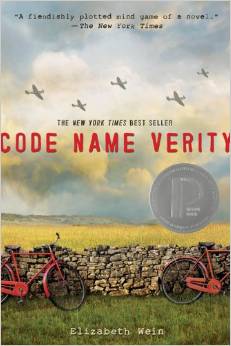During our past three summers at the University of Oxford, we’ve loved getting to know this amazing little city with all its hidden treasures. It seems that everywhere you turn in Oxford, you’ve stumbled upon another piece of literary history. As we get excited for summer number 4 at Oxford’s Somerville College, here is a list of some of our favorite literary sites (and accompanying literature) to visit every year.
Christ Church College

The quad at Christ Church College.
Although each of Oxford’s 38 constituent colleges is a sight to see, Christ Church is one of the most literary. It’s where Charles Dodgson (Lewis Carroll) first met the Dean of the College’s daughter, Alice Liddell, who became the inspiration for Alice’s Adventures in Wonderland. This is an especially exciting visit for Alice fans during the 150th anniversary of Carroll’s most beloved novel.
As if that were not enough literary history for one place, Christ Church College was used to recreate the iconic Hogwarts staircase and dining hall in the Harry Potter films.
Accompanying reading material: The Story of Alice by Robert Douglas-Fairhurst

GB Oxford students enjoying an Alice in Wonderland cream tea at Cafe Loco.
Right across from Christ Church College are two shops dedicated to all things Alice, also especially suitable during the 150th anniversary of Alice’s Adventures in Wonderland. The first, Alice’s Shop, was the inspiration of the Sheep’s Shop that Alice visits in Through the Looking Glass. Today, this shop is dedicated to all thing Alice, where one can find everything from Alice-themed toys and books to tea towels and jewelry.
Next door is Café Loco, an Alice in Wonderland themed tea shop where you can immerse yourself in a traditional cream tea with a Mad Hatter twist.
Accompanying reading material: Through the Looking Glass by Lewis Carroll
New College
If you walk fifteen minutes north of Christ Church College, you’ll come across New College, another of the constituent colleges used in the Harry Potter movies. Our favorite spot at New College is the cloisters, which are beautiful on their own, and even more exciting when you realize you’re standing by the very tree where Mad Eye Moody turns Malfoy into a ferret in The Goblet of Fire.
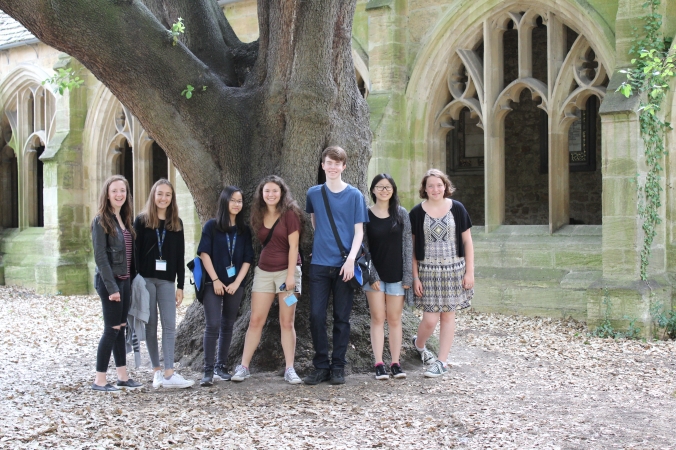
The cloisters at New College, where scenes from Harry Potter were filmed.
The Eagle & Child Pub
 A little further north, this public house was a frequent meeting place for the Inklings, a group of Oxford dons which most notably included J.R.R. Tolkein and C.S. Lewis, of Lord of the Rings and Narnia fame, respectively. Known locally as “the Bird and the Baby,” the Eagle and Child is a great place to stop for sustenance, literary inspiration, and a pint (if you’re old enough). We recommend the Cheddar, Potato and Spinach Pie.
A little further north, this public house was a frequent meeting place for the Inklings, a group of Oxford dons which most notably included J.R.R. Tolkein and C.S. Lewis, of Lord of the Rings and Narnia fame, respectively. Known locally as “the Bird and the Baby,” the Eagle and Child is a great place to stop for sustenance, literary inspiration, and a pint (if you’re old enough). We recommend the Cheddar, Potato and Spinach Pie.
Accompanying reading material: The Fellowship: The Literary Lives of the Inklings by Philip and Carol Zaleski
Wolvercote Cemetery
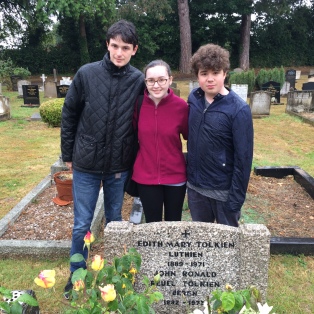
GB Oxford students pay homage to Tolkien at Wolvercote Cemetery.
Wolvercote Cemetery is a ten-minute bus ride from downtown, and we found the bus ride to be almost as much fun as the visit—most of us had never ridden on the top level of a double-decker bus before!
The key site on this visit is J.R.R. Tolkein’s grave. He and his wife are buried under a rose garden plot bearing a headstone labeled “Luthien” and “Beren.” Hard core Lord of the Rings fans will remember the story of Beren, a mortal man, and Luthien, his immortal elf-maiden wife who chooses mortality for her love. It’s a very touching detail, and like any good literary pilgrimage spot, it’s a good place to meet fellow lovers of Tolkein’s works and share in a dedicated reading of The Hobbit.
Also buried at Wolvercote are numerous Oxford scholars, including Sir Isaiah Berlin, a philosopher who is frequently featured in our Great Books curriculum.
Accompanying reading material: The Silmarillion by J.R.R. Tolkein
Blackwell’s Bookshop
Blackwell’s is a required destination for any bibliophile. The shop’s small façade belies the absolute mountains of books hidden beneath it. A visit to Blackwell’s starts out normally enough: you enter the first floor of what looks like a perfectly normal bookstore.
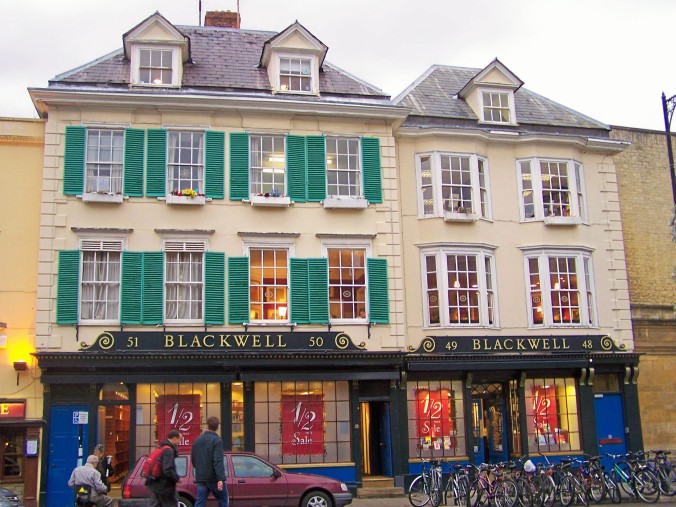
Blackwell’s misleadingly small storefront
Then you turn a corner, and find a staircase. At the end, a gigantic room of books…and another staircase. It’s hard to find the end of this amazing bookstore. Blackwell’s has its own art shop, a cartography room, an entire print music store, and more book-loving gifts and memorabilia than you are likely to find anywhere else.

Not nearly all the books inside Blackwell’s.
Accompanying reading material: Literally anything you can or cannot imagine.
Are you interested in visiting these amazing sites of English literary history? Join us at Oxford for an unforgettable summer of literature and travel.
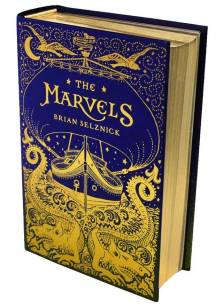
 The Heart Goes Last
The Heart Goes Last 


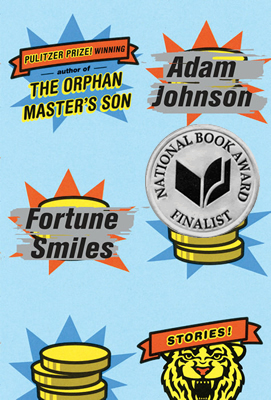 I always have difficulty reading collections of short fiction, so I was dismayed to see that there were two short story collections among the five fiction nominees this year. I have trouble keeping track of point of view shifts when I’m trying to read quickly, and this makes me try and find coherence among stories that are not necessarily connected. This was certainly my struggle with Fortune Smiles, which tells stories as diverse as: a Silicone Valley tech developer and his recently paralyzed wife; a UPS driver in Louisiana in the aftermath of two devastating hurricanes; a breast cancer patient and her author husband; a pedophile computer programmer and the children he cares for; a former Stasi prison guard who denies the injustices of his past; and a pair of North Korean defectors trying to adapt to life in Seoul.
I always have difficulty reading collections of short fiction, so I was dismayed to see that there were two short story collections among the five fiction nominees this year. I have trouble keeping track of point of view shifts when I’m trying to read quickly, and this makes me try and find coherence among stories that are not necessarily connected. This was certainly my struggle with Fortune Smiles, which tells stories as diverse as: a Silicone Valley tech developer and his recently paralyzed wife; a UPS driver in Louisiana in the aftermath of two devastating hurricanes; a breast cancer patient and her author husband; a pedophile computer programmer and the children he cares for; a former Stasi prison guard who denies the injustices of his past; and a pair of North Korean defectors trying to adapt to life in Seoul. This 736-page novel, also short-listed for the Man Booker Prize, is a daunting masterpiece. It follows four college roommates—JB the artist, Willem the actor, Malcolm the architect, and Jude the lawyer—as they grow, struggle, and become successful in their fields. At first, I despaired; I did not have the patience to read the struggle-until-you-make-it stories of four privileged men in New York City for more than 700 pages. Thankfully, the focus of this novel shifts primarily to Jude, the friend whose mysterious past separates him from the others, and which they sometimes resent. Over the course of the novel, we follow Jude into the secrets of his past while watching their ramifications unfold in his present.
This 736-page novel, also short-listed for the Man Booker Prize, is a daunting masterpiece. It follows four college roommates—JB the artist, Willem the actor, Malcolm the architect, and Jude the lawyer—as they grow, struggle, and become successful in their fields. At first, I despaired; I did not have the patience to read the struggle-until-you-make-it stories of four privileged men in New York City for more than 700 pages. Thankfully, the focus of this novel shifts primarily to Jude, the friend whose mysterious past separates him from the others, and which they sometimes resent. Over the course of the novel, we follow Jude into the secrets of his past while watching their ramifications unfold in his present. This novel tells the story of the Turner family, their thirteen children, and their house in Detroit. It jumps back and forth in time, between the Turners’ initial migration from Arkansas to Detroit in the 1940s, and their children’s present-day personal struggles. Most compelling among these is the eldest son, Cha-Cha’s, haunting by a “haint” as he tries to keep his family together through a period of change. The changes within the family are clearly mirrored by the changes to their neighborhood in Detroit.
This novel tells the story of the Turner family, their thirteen children, and their house in Detroit. It jumps back and forth in time, between the Turners’ initial migration from Arkansas to Detroit in the 1940s, and their children’s present-day personal struggles. Most compelling among these is the eldest son, Cha-Cha’s, haunting by a “haint” as he tries to keep his family together through a period of change. The changes within the family are clearly mirrored by the changes to their neighborhood in Detroit. This book is probably the most popular of the five nominees, so I was confused by how little I was enjoying the first half of the book. It tells the story of a young married couple, Mathilde and Lotto (short for Lancelot, of course) as they struggle to come into their own as artists and lovers. The first half of the book, “Fates,” is from Lotto’s perspective, and I did not enjoy reading about this vapid actor/playwright who barely acknowledges his wife within his narrative. As I have already mentioned, I have very little patience for the struggles of the artistic bourgeoisie.
This book is probably the most popular of the five nominees, so I was confused by how little I was enjoying the first half of the book. It tells the story of a young married couple, Mathilde and Lotto (short for Lancelot, of course) as they struggle to come into their own as artists and lovers. The first half of the book, “Fates,” is from Lotto’s perspective, and I did not enjoy reading about this vapid actor/playwright who barely acknowledges his wife within his narrative. As I have already mentioned, I have very little patience for the struggles of the artistic bourgeoisie. This is another short story collection, which, again, I have difficulty reading even when I’m not rushing through self-imposed reading challenges. I therefore appreciated that this collection of short stories was unified around the theme of money; all of the characters are motivated by needing, wanting, getting, and having money. Karen Bender is excellent at rendering relationships between characters, whether the wealthy grandfather and his estranged granddaughter, the husband and wife in debt, or the woman grieving the sudden death of her friend. I also really enjoyed Bender’s writing style; it’s simple, but beautiful in that way that addresses universal concepts in ways you’ve never thought about before. I kept finding myself highlighting phrases and thinking, “huh, I’ve never thought about competition between siblings like that before, but you’re absolutely right.” While I did appreciate a unifying theme to tie the stories together, I felt that the characters portrayed were less diverse and uniquely interesting than those from Adam Johnson’s Fortune Smiles.
This is another short story collection, which, again, I have difficulty reading even when I’m not rushing through self-imposed reading challenges. I therefore appreciated that this collection of short stories was unified around the theme of money; all of the characters are motivated by needing, wanting, getting, and having money. Karen Bender is excellent at rendering relationships between characters, whether the wealthy grandfather and his estranged granddaughter, the husband and wife in debt, or the woman grieving the sudden death of her friend. I also really enjoyed Bender’s writing style; it’s simple, but beautiful in that way that addresses universal concepts in ways you’ve never thought about before. I kept finding myself highlighting phrases and thinking, “huh, I’ve never thought about competition between siblings like that before, but you’re absolutely right.” While I did appreciate a unifying theme to tie the stories together, I felt that the characters portrayed were less diverse and uniquely interesting than those from Adam Johnson’s Fortune Smiles.
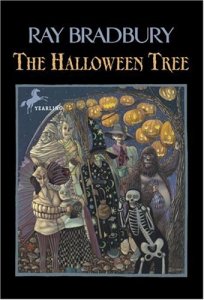
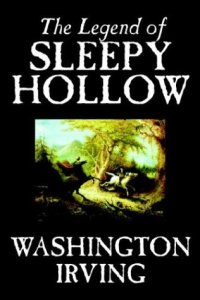

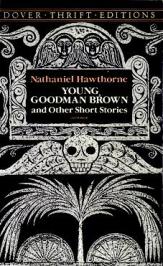



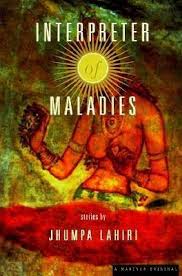



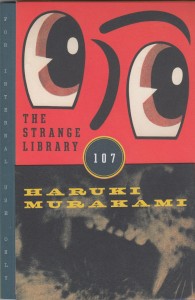
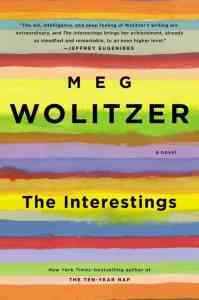



 as Carol
as Carol
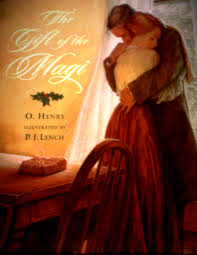 he Gift of the Magi
he Gift of the Magi






